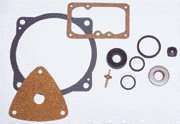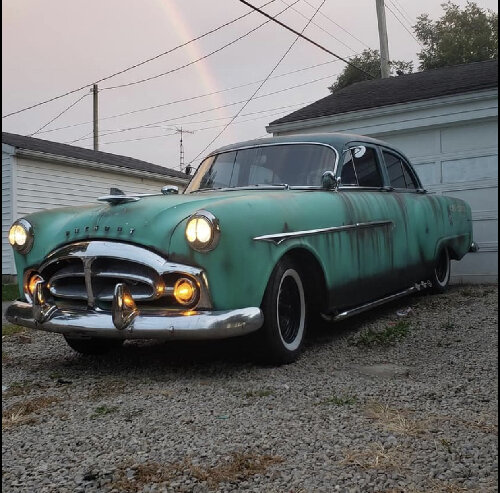|
Re: CAUTION ON THE USE OF SILICONE BKAKE FLUID IN ESAMATIC BRAKE SYSTEMS
|
||||
|---|---|---|---|---|
|
Forum Ambassador

|
I don't doubt that people have had failures of Treadle-Vac units, some perhaps due to incorrect rebuilds or other factors but my own experience over many years and miles is quite the opposite. Many years back I drove a 54 Patrician as an everyday car for 15 years and my current 56 for about 11 with no problems and although I know of folks who have had their units rebuilt for peace of mind, I don't personally know of anyone who has ever had a unit fail to the point of no brakes. Leaking brake fluid into the vacuum section, yes -- but outright failure - no. The same type unit was used on millions of GM and Ford products in that era, perhaps researching their service bulletins might be enlightening.
Posted on: 2007/10/24 8:04
|
|||
|
||||
|
Re: CAUTION ON THE USE OF SILICONE BKAKE FLUID IN ESAMATIC BRAKE SYSTEMS
|
||||
|---|---|---|---|---|
|
Home away from home

|
Quote:
Many years back I drove a 54 Patrician as an everyday car for 15 years and my current 56 for about 11 with no problems and although I know of folks who have had their units rebuilt for peace of mind, I don't personally know of anyone who has ever had a unit fail to the point of no brakes. I do, his name is Craig Hendrickson.
Posted on: 2007/10/24 13:05
|
|||
|
||||
|
Re: CAUTION ON THE USE OF SILICONE BKAKE FLUID IN ESAMATIC BRAKE SYSTEMS
|
||||
|---|---|---|---|---|
|
Forum Ambassador

|
Peter -
Many vehicles of that era used the TreadleVac system, including highly-popular cars like the 55-56-57 Chevy - not just Packard. If there was a genuine design problem with it, something would have been published long ago. While I doubt that anyone involved in design and production of those automobiles and their component parts (back then) ever envisioned people driving them so many decades later, those old cars were (thankfully) built to be renewable. Yet, some people may not fully understand what they're working on, and people tend to fear (or even oppose) what they don't understand. In that regard, know that Bendix offered TWO levels of overhaul kits - minor and major = throughthe after market (as well as the aftermarket). The minor kit contained only those parts that were required to rebuild the hydraulic section; everything you need to upgrade the T-V master cylinder to DOT5 is in that kit. That kit was reproduced decades ago and remains widely available today, and I prefer fresh rubber parts to 50+ year old NOS ones (provided they are of sufficient quality). Attached is a pic I snagged from Kanter's site (www.kanter.com/p08-bk.html), showing the contents of that (minor) overhaul kit. Notice that it includes a new compensator port valve, but NOT the fine-wire spring. The major overhaul kit included the additional parts that were needed to overhaul both the hydraulic and vacuum sections, but I'm not sure if it included the compensator valve spring. I do have an NOS major kit somewhere (not for sale) in offsite storgae; if I can ever get time and can lay my hands on it, I will take a pic, inventory the contents, and report back here. Now, anyone smart enough to take one of these units apart and put it back together would notice something like a pitted hydraulic plunger/piston, but it was not included in either of the kits - had to be purchased separately. Yet, my point is that the compensator port valve spring is one of those things that is often overlooked - especially by those who do not understand its purpose and function. The 1955-56 Packard Service Manual explains the TreadleVac operation better than the "restorograph" sheet included with some overhaul kits. With a little patience, operation of that valve can be checked with the unit still in the car. The reservoir cover can usually be removed without ruining the gasket, though you might have to remove some fluid from the reservoir to see it. Also, during a rebuild, one should inspect this spring for corrosion as the spring will break in that point. Attach file:  (3.63 KB) (3.63 KB)
Posted on: 2007/10/26 13:57
|
|||
|
||||
|
Re: CAUTION ON THE USE OF SILICONE BKAKE FLUID IN ESAMATIC BRAKE SYSTEMS
|
||||
|---|---|---|---|---|
|
Home away from home

|
Strange that the compensator port spring is not included in the kits.
Posted on: 2007/10/27 8:49
|
|||
|
||||
|
Re: CAUTION ON THE USE OF SILICONE BKAKE FLUID IN ESAMATIC BRAKE SYSTEMS
|
||||
|---|---|---|---|---|
|
Forum Ambassador

|
To the best of my knowledge the spring never was part of that kit - even in the original Bendix package. Again, neither was the plunger/piston. However, such additional parts were available, separately, from dealers and parts stores alike (back in the day).
It seems to me that the minor kit was intentded for replacing the components that were most likely to wear out and leak (and those sacrificed in getting at them). Again, I doubt if Bendix or any of the automakers anticipated their vehicles being in use half a century later, and the damage caused by moisture entering the hydraulic system occurs over a long period of time.
Posted on: 2007/10/27 16:00
|
|||
|
||||
|
Re: CAUTION ON THE USE OF SILICONE BKAKE FLUID IN ESAMATIC BRAKE SYSTEMS
|
||||
|---|---|---|---|---|
|
Just popping in

|
Read with great interest everybody's comments on the Treadle-Vac. I've been rebuilding these things for myself and a couple of friends for almost 30 years. I drove my rebuilds reliably in two cars for fifteen years to and from work in Fresno and Long Beach, California, and across the country to the east coast and back, twice, as well as other trips to Fort Worth, Portland, Las Vegas, the central California coast, etc.
Many years ago I was blessed with the good fortune of locating a Bendix power brake technical binder containing extensive parts listings and procedures. I found it at "Acres of Books" in Long Beach, and paid a goodly sum for it, since "Acres of Books" charges by the inch. Having this resource at my fingertips allows me to confirm the contents of repair kits for Bendix Power-Vac, Master-Vac, Hydro-Vac, Treadle-Vac, and numerous other Bendix products of the 1940's and 1950's. For the group's benefit, I list here the complete contents of the four repair kits that Bendix made available for 1955-56 Packard Treadle-Vac: Minor Repair kit: Guard - Push Rod (boot) Gasket - End plate (the triangular cork gasket) "C" Washer - Compensating Valve Seal - Compensating Valve Fitting Poppet and Stem - Compensating Valve Seal - Hydraulic Outlet Fitting Cup - Residual Check Valve Gasket - Cover, Fluid reservoir Cup - Hydraulic Plunger Washer - Hydraulic Plunger (fiber) Seal - Hydraulic Plunger (leather) Seal - Master Cylinder End (rubber) Gasket - Flange (the large roughly square one) Gasket - Air cleaner screw (a small rubber washer) Gasket - Plate and tube (for the vacuum inlet fitting) Major Repair kit: All of the above plus: Seal - Push rod Seal - Tube plate Atmospheric Poppet Vacuum Poppet Clips (for Vacuum poppet) Quan. 2 Gasket - Diaphragm Don't expect a new push rod guard (boot) with kits you buy today...that is an extra-cost item (around $15). Note also the "C" washer that retains the compensator spring was included in the minor and major repair kits, but neither contained the spring itself. Today, expect to have to re-use *both* parts from your old unit, as neither part is provided in new kits. Piston Packing and Diaphragm kit: Tube - Vacuum (the short curved rubber hose) Spring - Piston Packing Expanding Wick - Piston Packing Packing - Piston (Leather) Seal - Tube Plate Diaphragm Gasket - Diaphragm Poppet Replacement kit: Diaphragm - Vacuum Poppet Compensator Atmospheric Poppet Spring - Atmospheric Poppet Vacuum Poppet Clips (for Vacuum poppet) Quan. 2 Snap Ring Gasket - Diaphragm Notice with the Bendix kits, you really didn't get everything unless you bought all four, and even then you still didn't get that lousy compensator spring. On DOT5 fluid, have not used it myself, but I've heard generally negative comments about using it with Treadle-Vacs. Would like to hear any positive experience from someone who has used it successfully over an extended period. The only things I've ever had fail on my Treadle-Vac were the leather piston seal and the compensator valve and stem, and in both cases they simply began to seep a little...nothing sudden, nothing catastrophic. BTW, the book recommends the 1956 Packard unit (P-4) as the service replacement for for 1955 early (P-2) and 1955 late (P-3) Packard Treadle-Vacs. The identification numbers can be found stamped into the vertical end of the Treadle-Vac master cylinder. Wish I knew more about this Craig Henderickson fellow, and what the nature of his brake failure was. Hope this helps someone.
Posted on: 2007/10/29 23:24
|
|||
|
||||
|
Re: CAUTION ON THE USE OF SILICONE BKAKE FLUID IN ESAMATIC BRAKE SYSTEMS
|
||||
|---|---|---|---|---|
|
Webmaster
|
Now that book would be a great reference for the website! Sorry just thinking outloud.
Posted on: 2007/10/29 23:43
|
|||
|
-BigKev
1954 Packard Clipper Deluxe Touring Sedan -> Registry | Project Blog 1937 Packard 115-C Convertible Coupe -> Registry | Project Blog |
||||
|
||||
|
Re: CAUTION ON THE USE OF SILICONE BKAKE FLUID IN ESAMATIC BRAKE SYSTEMS
|
||||
|---|---|---|---|---|
|
Just popping in

|
Peter Packard, the compensator stem tip was sheared off because you probably didn't assemble the unit properly.
When installing the compensator fitting in the bottom of the reservoir, it is necessary to apply the pedal or, if not mounted on the car, push the input rod in a bit first. Then release the pedal or input rod and verify the visible portion of the compensator valve stem tilts forward, indicating the port is open to allow fluid return. When the pedal is applied, the stem is released, and the compensator port closes allowing the application of hydraulic pressure to the slave cylinders. Then, when the brakes are released, the valve stem is pushed aft from below (indicated by the upper part of the stem tilting forward) again allowing the brake fluid to return to the reservoir. Contrary to what was posted here previously, the residual check valve is there to maintain a minimum of about 10 psi in the brake lines which "preloads" the system a bit resulting in higher pedal and quicker brake response. Also, an old-style slave cylinder will tend to "gulp" air from the atmosphere when pressure is relieved. The 10 psi residual prevents air gulping at the slave cylinders. Gauss
Posted on: 2007/10/30 0:05
|
|||
|
||||
|
Re: CAUTION ON THE USE OF SILICONE BKAKE FLUID IN ESAMATIC BRAKE SYSTEMS
|
||||
|---|---|---|---|---|
|
Home away from home
|
G'day Gauss, I am sure that you are correct in saying that the compensator valve stem sheared off because I did not assemble it correctly into the T-V. I know better now. Live and learn. Thanks for the info. Peter Toet
Posted on: 2007/10/30 0:55
|
|||
|
I like people, Packards and old motorbikes
|
||||
|
||||








